When the days become warm and the sun stays up until after dinner, cooking and eating outdoors makes mealtime more fun and flavorful. Grilling turns up the taste of many foods, including the non-starchy vegetables that are so important to your Nutrisystem weight loss plan. Cooking over an open flame brings out the natural sweetness of many veggies while infusing them with a rich, charred flavor. Keep reading to find out the 10 best vegetables to grill this season. Plus, learn more about their health benefits and score some of our favorite grilled vegetable recipes.
1. Artichokes
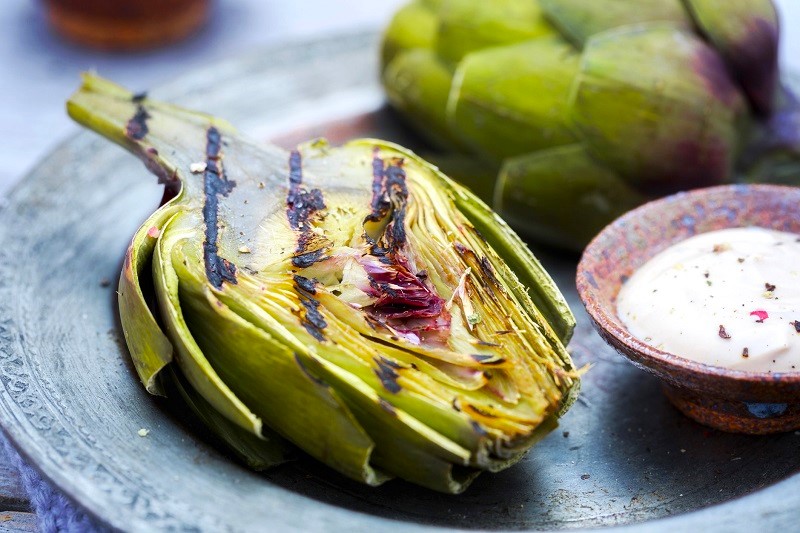
Artichokes are the unopened flower buds from a certain type of thistle plant. They are at their peak in spring to early summer. When raw, artichokes are firm and hard to bite into. Grilling tenderizes them while adding a smoky note to their lightly nutty flavor.
Why: A medium-size artichoke has about seven grams of fiber, which keeps you feeling full long after you eat. Artichokes are a good vegetable source of potassium, a mineral that plays a key role in managing your blood pressure and metabolism.
Try: Artichokes can take a long time to cook, so most pros recommend steaming them before putting them on the grill to finish cooking. Start by slicing each one in half lengthwise and steam them for 15 to 20 minutes. Brush each half with a little olive oil and herbs such as thyme and rosemary. Set them on the grill for about 5 minutes on each side. Grilled artichokes can be eaten as a side dish alone or used to add flavor and fiber to dips. They also can be stuffed with brown rice and ground meat or sliced as a topping for pizza.
2. Asparagus
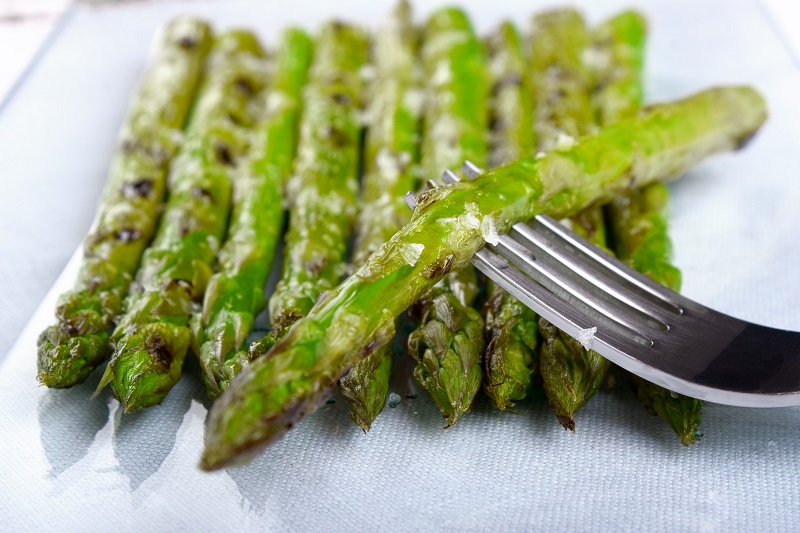
Asparagus is one of the best vegetables to grill! Many people who do not care for steamed asparagus love the taste and texture when it’s grilled. The bright green spears come out soft but not mushy, charred on the outside and juicy on the inside.
Why: With a half-cup serving of asparagus, you get more than two grams of protein, along with key nutrients such as vitamin A and folate. Asparagus has healthy amounts of fiber, antioxidants and potassium.
Try: Before putting the spears on a medium hot grill, toss them with a little olive oil and pepper. Once they feel tender to your tongs and have a few black spots on the outside, they’re ready. Grilled asparagus is delicious enough to eat alone but it also works well in many other dishes. We use them to make a tasty variation on a classic side dish in this Grilled Asparagus Caesar Salad recipe.
3. Beets

As the flame heats up beets, it releases their natural sugars and juices, making them exceptionally sweet and tender. If you’d like your meal to be colorful, look for varieties of beets that have pink and white stripes inside or that are golden yellow, as well as the classic deep red. You’ll find them in spring and early summer in many grocery stores and farmers markets.
Why: Even though beets have a high sugar content, a half-cup serving has less than 10 grams of carbohydrates. The roots also are high in manganese, a mineral your body needs to process other nutrients. Beets helped to lower the blood pressure of older, overweight people who participated in study, published in the scientific journal Nutrition Research.
Try: As your grill is warming up to medium heat, cut the beets into round slices about one-quarter-inch thick. Toss them with a little olive oil, salt and pepper. Place them on the grilling rack for about eight to 10 minutes, then turn them over and cook for about the same amount of time on the other side. When finished, you can use them in a salad with spring greens, such as our recipe for Arugula Beet Salad with Orange Slices. For a simple, filling dish, sprinkle a little feta or chevre cheese on top of the grilled beets. Add extra flavor to a sandwich or burger by using sliced beets in place of tomatoes.
4. Cauliflower
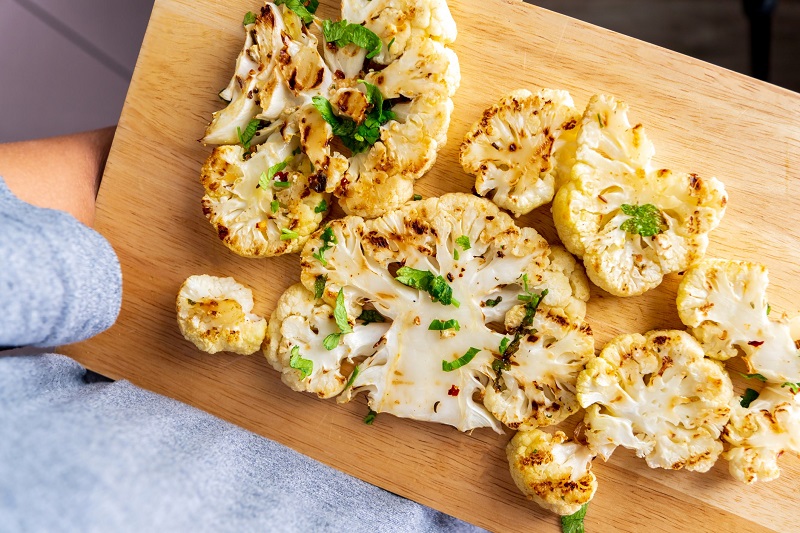
This member of the cabbage family has become one of the most versatile veggies and a powerful aid for weight loss. Sturdy cauliflower florets hold up well to grilling, making them one of the best vegetables to grill. It adds a lightly smoky taste to their otherwise mild flavor.
Why: A half-cup of cauliflower gives you more than half of your daily needs for vitamin C, an essential nutrient for fueling your immune system. It is high in antioxidants, which help protect you from different types of cancer. It also contains choline, a micronutrient that has been shown to help with sleep, memory and learning.
Try: Break or cut a head of cauliflower into large florets that will rest on the grill rack without falling through. After lightly coating them with olive oil and sprinkling on herbs such as rosemary and thyme, grill the cauliflower over medium heat for about eight minutes on each side, until they’re browned. For an even more tempting presentation, try our recipe for Grilled Cauliflower Steaks.
5. Eggplant
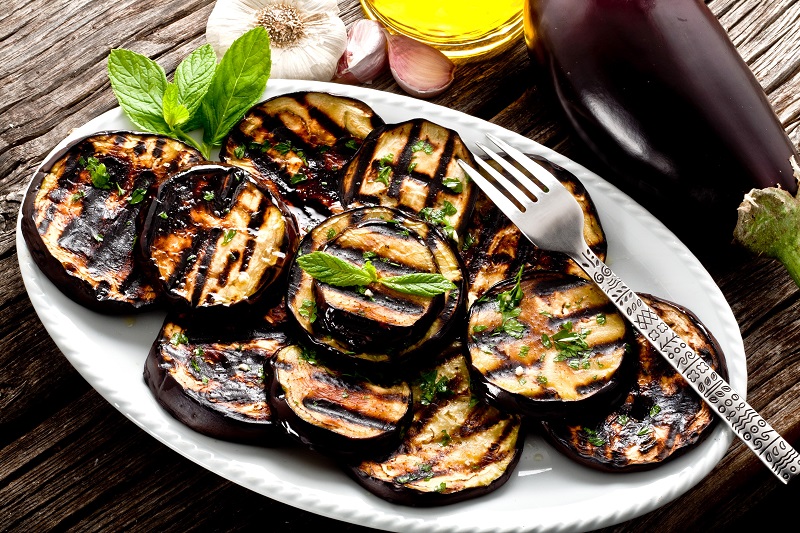
One of the most popular and best vegetables to grill, the bitter taste of raw eggplant softens and the flesh becomes tender on the grill. In spring and summer, when eggplant is at its peak across the U.S., you will find long green Asian-style varieties and smaller round types in white, yellow or lavender. You’ll also find the more common oblong deep purple eggplant. Larger eggplants slice up well for the grill, but smaller ones have a more subtle flavor.
Why: Along with its hefty load of vitamins A and C, eggplant provides your body with anthocyanins, nutrients that protect your cells from damage that can lead to cancer and other diseases.
Try: Start by slicing eggplant into quarter-inch thick pieces and then lightly salt them to draw out the moisture. We like to brush the slices with a little olive oil and season them with garlic, parsley, Italian seasoning, smoked paprika and black pepper. Then cook them on a medium-hot grill. Our Grilled Eggplant recipe explains all the details!
6. Mushrooms
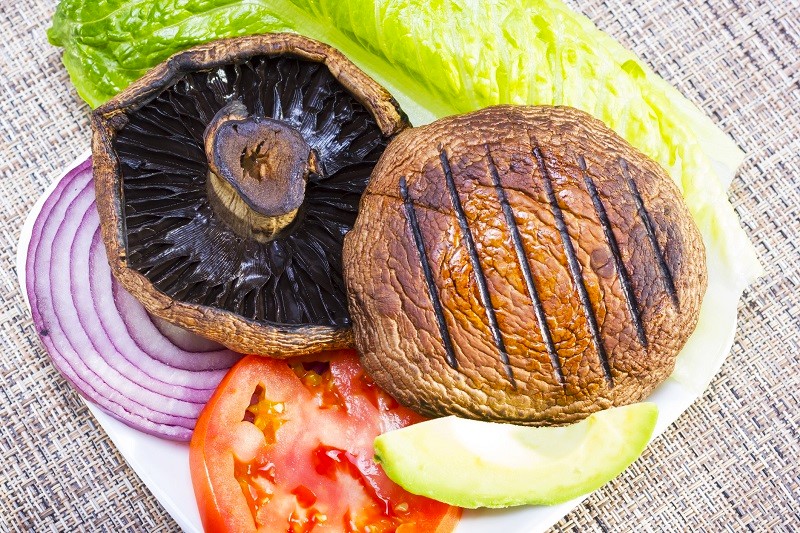
Mushrooms take on a smoky taste from the open flame that elevates their earthy flavor. This makes them one of the best vegetables to grill as a meaty vegetarian substitute for burgers or a savory companion for other dishes. Any type of mushroom can work on the grill, but big, beefy portobellos are especially well-suited for it.
Why: A portobello mushroom has about 2.2 grams of protein, along with significant amounts of essential minerals, including zinc, copper and selenium. “Various animal studies have demonstrated that regular consumption of mushrooms significantly reduces hypertension, atherosclerosis, inflammation, and obesity,” say researchers in a report, published in the scientific journal Molecules.
Try: Be sure to clean mushrooms thoroughly before grilling to remove any grit that clings to them. If you’re using portobellos, begin by scraping out the inside of the caps so you have a nice clean surface. Brush them with olive oil and balsamic vinegar and sprinkle on black pepper to taste. Cook mushrooms over a medium flame with the open side down for about five minutes. Once they’re done, you can use them as a replacement for meat patties in a burger. You could also slice them up and use them in a medley with other grilled vegetables like eggplant and onions. Try our Grilled Stuffed Portobello Mushroom recipe and enjoy a filling, delicious, meat-free meal!
7. Onions
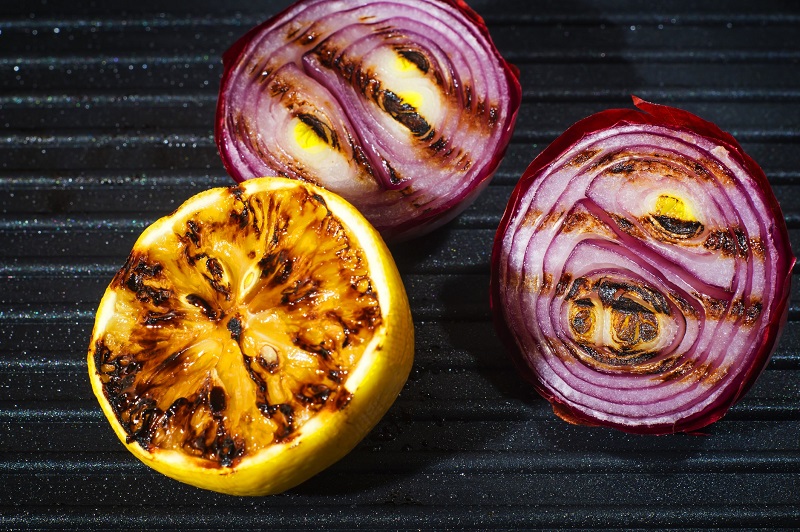
The zesty taste of onions puts a little zing in so many kinds of dishes. Grilling them brings out their sweetness and softens their sharp bite. You can use any type on the grill, but large, sweet Vidalia onions and big red onions hold up best.
Why: Onions are an allium vegetable and are rich in antioxidants like vitamin C, which may promote the production of collagen in the body. They also contain compounds called organosulfurs, some of which have been shown to have antioxidant properties.
Try: Thick slices of onion can go right on the grill alongside your favorite burger patty. Just wait until the burgers are nearly done because onions cook much faster. Cook thinner onion rounds on a grill pan until they begin to brown and then use them as a topping for salmon or chicken breasts. For a quick, complete meal, try our Steak Stir-fry recipe with Grilled Peppers and Onions.
8. Peppers
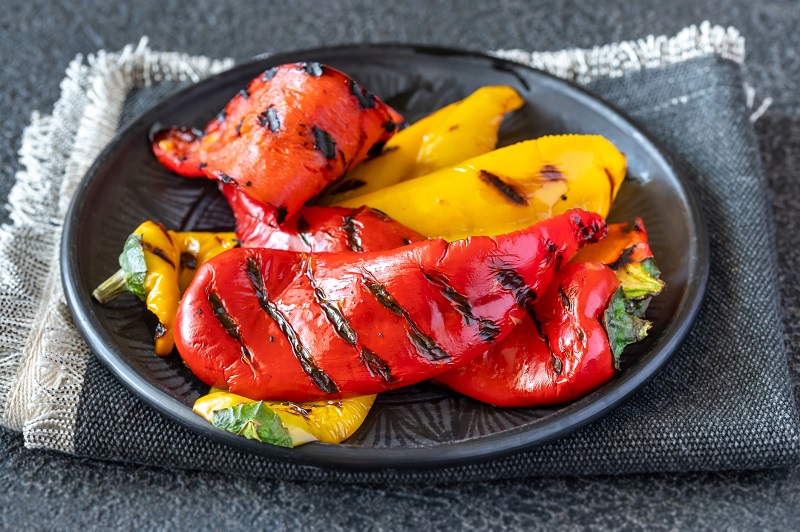
Whether you like peppers sweet, hot or both, grilling them unleashes even more flavor. Varieties with thick walls, like bell peppers and poblano chili peppers, are the best vegetables to grill for kabobs and other dishes. Sweet banana and cayenne peppers are good choices for using in fajitas or as pizza toppings.
Why: Peppers of all kinds are a rich source of vitamin C and provide some important potassium. Hot peppers, even mild varieties like jalapenos, contain capsaicin, the compound that warms up your tongue. Many studies have found that capsaicin revs up your metabolism while also keeping your appetite satisfied for hours.
Try: Peppers are juicy enough to go right onto the grill, but you can drizzle them with a little olive oil first to help the outside char up nicely. Kick up the flavor of turkey hot dogs or turkey sausage with a topping of grilled peppers, with or without onions. Give homemade salsa or marinara sauce a richer taste with grilled peppers.
9. Radicchio
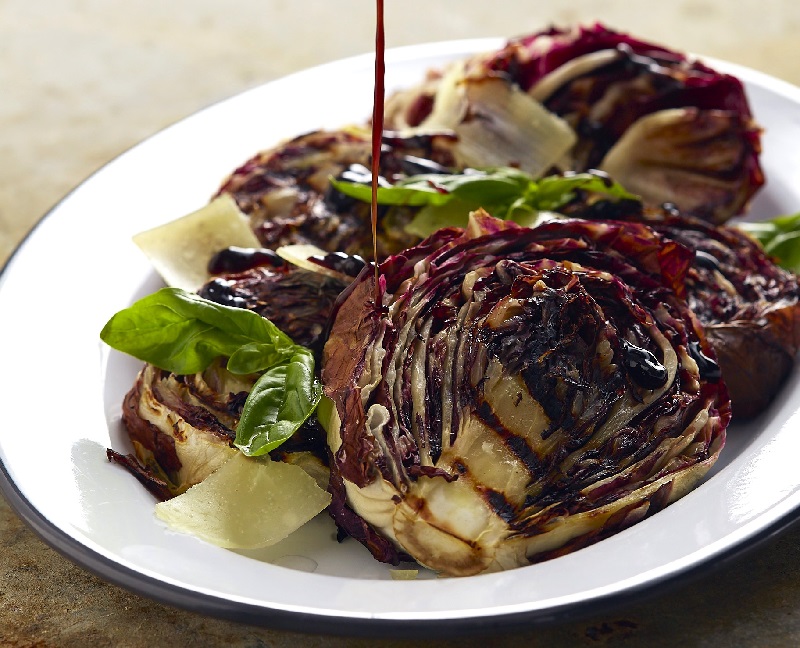
Most greens can be challenging to grill because they are so delicate, though you can give Caesar salad extra flavor if you very quickly char the romaine lettuce first. Radicchio has the shape and density of cabbage, so it’s sturdy enough for grilling. Cooking it over a flame sweetens its lightly bitter flavor. Plus, after grilling the deep red and white leaves look beautiful in many dishes.
Why: A cup of radicchio has less than 10 calories and fills you up with fiber, so you aren’t hungry soon after eating. Technically, radicchio is neither a kind of lettuce nor cabbage, but a relative of chicory. After giving test subjects chicory root extract, researchers concluded that it “could delay or prevent the early onset of diabetes,” according to a report, published in the Journal of Traditional and Complementary Medicine.
Try: When buying radicchio, be sure the head feels kind of heavy and solid. That’s a sign it doesn’t have a hollow core. As your grill gets medium hot, cut the head of radicchio in half or in wedges (depending on how big it is), then brush each side with olive oil. Sprinkle on pepper to taste and a little salt, then place on the grill rack. Rotate the pieces as each side turns brown on the edges, typically after about three minutes. Use the grilled radicchio to make a slaw that’s popping with flavor or use the leaves as wraps for grain salad. You can also keep it simple and just eat it alone with one of our three delicious DIY salad dressing recipes.
10. Zucchini
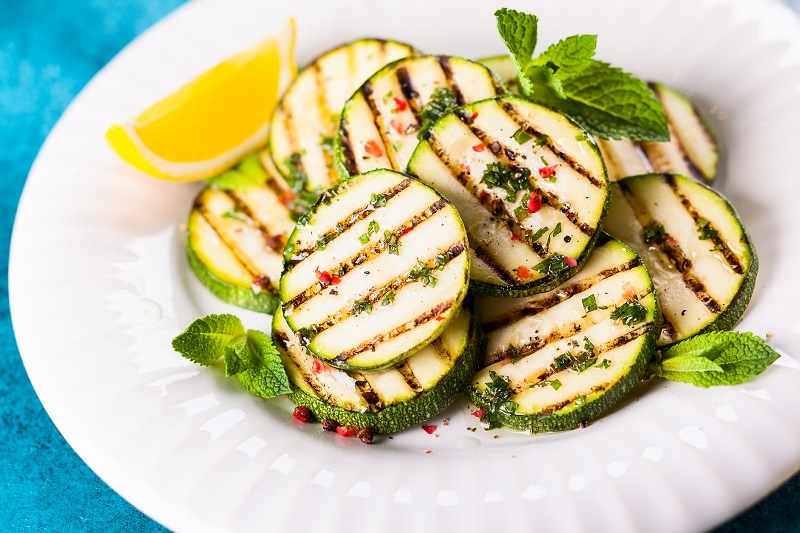
The mild flavor of summer squash perks up after grilling. Zucchini, and their cousin yellow summer squash, are similar in taste and texture, so you can mix and match them to give your meals a bright color. They are two of the best vegetables to grill because they’re in season and super versatile.
Why: Zucchini is a good source of vitamin B6, a nutrient that helps regulate blood sugar levels. The green squash also are rich in zeaxanthin, a compound found in many dark green vegetables. Zeaxanthin extract helped prevent or reverse obesity in a study of lab animals published in the journal Nutrients.
Try: Zucchini tends to get denser as it grows larger. Big ones work great if you’re going to hollow them out and stuff them with other ingredients. Go for medium to small zucchini for grilling them as a side dish. They benefit from a light brushing of olive oil, black peppers and herbs such as oregano and rosemary. Our recipe for Grilled Shrimp and Scallop Skewers is a complete summer meal that’s elegant enough for company but so simple you can enjoy it any day of the week.

